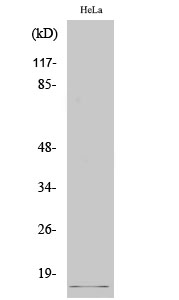Cleaved-SUMO-2/3 (G93) Polyclonal Antibody
- Catalog No.:YC0075
- Applications:WB;ELISA;CoIP
- Reactivity:Human;Mouse;Rat
- Target:
- SUMO-2/3
- Fields:
- >>Nucleocytoplasmic transport;>>Fluid shear stress and atherosclerosis
- Gene Name:
- SUMO2 SUMO3
- Protein Name:
- Small ubiquitin-related modifier 2
- Human Gene Id:
- 6613
- Human Swiss Prot No:
- P61956/P55854
- Mouse Gene Id:
- 170930
- Mouse Swiss Prot No:
- P61957
- Rat Gene Id:
- 690244
- Rat Swiss Prot No:
- P61959
- Immunogen:
- The antiserum was produced against synthesized peptide derived from human SUMO2/3. AA range:44-93
- Specificity:
- Cleaved-SUMO-2/3 (G93) Polyclonal Antibody detects endogenous levels of fragment of activated SUMO-2/3 protein resulting from cleavage adjacent to G93.
- Formulation:
- Liquid in PBS containing 50% glycerol, 0.5% BSA and 0.02% sodium azide.
- Source:
- Polyclonal, Rabbit,IgG
- Dilution:
- WB 1:500 - 1:2000. ELISA: 1:20000. IP 1:50-100 Not yet tested in other applications.
- Purification:
- The antibody was affinity-purified from rabbit antiserum by affinity-chromatography using epitope-specific immunogen.
- Concentration:
- 1 mg/ml
- Storage Stability:
- -15°C to -25°C/1 year(Do not lower than -25°C)
- Other Name:
- SUMO2;SMT3A;SMT3H2;Small ubiquitin-related modifier 2;SUMO-2;HSMT3;SMT3 homolog 2;SUMO-3;Sentrin-2;Ubiquitin-like protein SMT3A;Smt3A
- Observed Band(KD):
- 11kD
- Background:
- This gene encodes a protein that is a member of the SUMO (small ubiquitin-like modifier) protein family. It functions in a manner similar to ubiquitin in that it is bound to target proteins as part of a post-translational modification system. However, unlike ubiquitin which targets proteins for degradation, this protein is involved in a variety of cellular processes, such as nuclear transport, transcriptional regulation, apoptosis, and protein stability. It is not active until the last two amino acids of the carboxy-terminus have been cleaved off. Numerous pseudogenes have been reported for this gene. Alternate transcriptional splice variants, encoding different isoforms, have been characterized. [provided by RefSeq, Jul 2008],
- Function:
- function:Ubiquitin-like protein which can be covalently attached to target lysines either as a monomer or as a lysine-linked polymer. Does not seem to be involved in protein degradation and may function as an antagonist of ubiquitin in the degradation process. Plays a role in a number of cellular processes such as nuclear transport, DNA replication and repair, mitosis and signal transduction. Covalent attachment to its substrates requires prior activation by the E1 complex SAE1-SAE2 and linkage to the E2 enzyme UBE2I, and can be promoted by an E3 ligase such as PIAS1-4, RANBP2 or CBX4.,online information:SUMO protein entry,PTM:Cleavage of precursor form by SENP1 or SENP2 is necessary for function.,PTM:Cleavage of precursor form by SENP1, SENP2 or SENP5 is necessary for function.,PTM:Polymeric chains can be formed through Lys-11 cross-linking.,similarity:Belongs to the ubiquitin family. S
- Subcellular Location:
- Nucleus. Nucleus, PML body.
- Expression:
- Broadly expressed.
SENP6-Mediated deSUMOylation of VEGFR2 Enhances Its Cell Membrane Transport in Angiogenesis INTERNATIONAL JOURNAL OF MOLECULAR SCIENCES Xiaohua Guo WB,CoIP Human human umbilical vein endothelial cells (HUVECs)
- June 19-2018
- WESTERN IMMUNOBLOTTING PROTOCOL
- June 19-2018
- IMMUNOHISTOCHEMISTRY-PARAFFIN PROTOCOL
- June 19-2018
- IMMUNOFLUORESCENCE PROTOCOL
- September 08-2020
- FLOW-CYTOMEYRT-PROTOCOL
- May 20-2022
- Cell-Based ELISA│解您多样本WB检测之困扰
- July 13-2018
- CELL-BASED-ELISA-PROTOCOL-FOR-ACETYL-PROTEIN
- July 13-2018
- CELL-BASED-ELISA-PROTOCOL-FOR-PHOSPHO-PROTEIN
- July 13-2018
- Antibody-FAQs
- Products Images

- Western Blot analysis of various cells using Cleaved-SUMO-2/3 (G93) Polyclonal Antibody

- Western blot analysis of lysates from HeLa cells, using SUMO2/3 (Cleaved-Gly93) Antibody. The lane on the right is blocked with the synthesized peptide.



